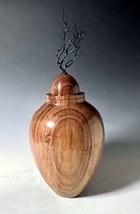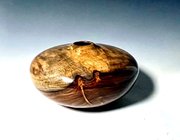Recently I entered the 44th annual Juried Regional Art Exhibition at the Midwest Museum of American Art in northern Indiana. This art exhibition accepts entries from over 20 Indiana & Lower Michigan counties. Both pieces I entered got accepted and won awards.
The museum Director found out I was legally blind and was impressed with the turnings I produce. He has asked me to do an presentation as part of their weekly noon-time Artist Talks. I'm scheduled to present on December 22nd. This talk is to include some artist background (which I think I can handle) and also about the history, processes, etc involved in the art of turning. This artist talk will be about 30-40min with time for Q & A afterwards. Format is powerpoint and talking.
Anyone ever do something similar and willing to share some of their presentation that I can adapt and modify? Or, suggestions on what to include or not include? Or info on the history of turning that can be easily and briefly presented within a few powerpoint slides? I need to plan some sort of outline so I can start roughing out the powerpoint presentation.
By the way, here are the two pieces that are in the Exhibition until Christmas. The tall enclode vessel is monkeypod wood with a finial of black sea fan coral. The shorter hollow form is Indian Rosewood


The museum Director found out I was legally blind and was impressed with the turnings I produce. He has asked me to do an presentation as part of their weekly noon-time Artist Talks. I'm scheduled to present on December 22nd. This talk is to include some artist background (which I think I can handle) and also about the history, processes, etc involved in the art of turning. This artist talk will be about 30-40min with time for Q & A afterwards. Format is powerpoint and talking.
Anyone ever do something similar and willing to share some of their presentation that I can adapt and modify? Or, suggestions on what to include or not include? Or info on the history of turning that can be easily and briefly presented within a few powerpoint slides? I need to plan some sort of outline so I can start roughing out the powerpoint presentation.
By the way, here are the two pieces that are in the Exhibition until Christmas. The tall enclode vessel is monkeypod wood with a finial of black sea fan coral. The shorter hollow form is Indian Rosewood


